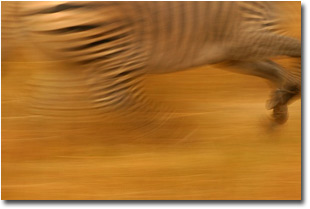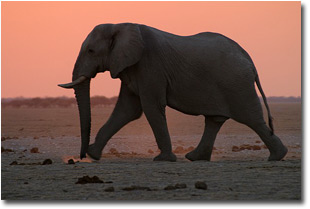Botswana – An African Experience
Text and photography copyright Peter Madeley
All rights reserved.
A trip to Botswana had long been on my most wanted list ever since I first saw Frans Lanting’s groundbreaking book Okavango – A Lost Eden. We did not know what to expect, other than the experience would contrast our previous African tours. This time we would be really out there, living in the bush, both day and night with our home being a small, but secure dome tent. Civilization is a long way from here and it can take some getting used to.
The first night at camp in the Nxai Pan National Park was filled with apprehension and exhilaration. Familiar noises of traffic and airplanes were replaced with an eerie silence, punctuated by the calling jackal and groaning lion and later in the early morning, the haunting hoot of a nearby white faced owl. Sleep was not easy - We lay there listening to everything, yet nothing.
The three days of viewing were clean, only baked and cracked salt pan, acacia and the baobabs marking the edge of the pan, to restrict the view from horizon to horizon. You can feel very small in a place like this. A pumped waterhole provided a focus for much of the viewing, as a small family of lion had made this their main hunting ground. We were privileged to witness the entire predator-prey spectacle of cubs being brought in, being left safely to watch several failed hunts before a springbok was successfully brought down, only to be unceremoniously stolen by a rogue male.
The edge of light, morning and evening proved to be spectacular, the harshness of the daylight giving way to gentle pinks, then deep oranges as the dust filtered the warm toned evening light. Giraffe, ostrich and elephant provided dramatic silhouettes against the setting sun. How quickly the sun seemed to set, before quickly dipping below the horizon and desaturating the landscape. This served as a cue to return to a welcoming camp, with blazing fire and excellent hot food. Stories around the campfire were of the encounters of the day-springbok, impala, zebra, lion, jackal, bat eared fox, elephant, ostrich, giraffe and how we seemed to be part of the whole scene.
A drive and small plane trip brought us to Shakawe, the main town of the Panhandle region of the delta and a very different landscape, dominated by the Okavango River with its tall stands of papyrus. Pied kingfishers were as common as Magpies and Malachite Kingfishers like little jewels of colour perched in the margins. Anhinga, Herons, Bee-eaters and Storks make this region a paradise for birders and photographers alike. A good boat-hand ensured we could achieve approach distances, of just a few metres without causing undue stress. Crocodiles are a common resident and were often spotted basking, but were less easy to get close to; apart from the one we startled which nearly hit the front of the 4 seater boat in its escape. Well we wanted up close encounters!! The luxurious Xaro lodge provided a two day opportunity to recharge human batteries, take a bitingly hot shower and meeting other fellow safari companions on other tours.
A return flight to Moremi Game Reserve ended at Bodumatau “Setswana name meaning 'where the lion roars'”. Camping on the margins of a crocodile infested pool with a deafening hippo serenade, the splashing of late evening drinking elephants and a midnight encounter with a hyena are experiences not quickly forgotten. Day encounters brought us face to face with lions and until you have seen them at close quarters, it is difficult to appreciate their full size. They are justifiably King of Beasts.
Our guide, Ewan, had a sixth sense, a deft perception of where to be and when, as time after time he brought us to waterholes just before lions came to hunt, or hundreds of elephants emerged from the bush to drink throwing plumes of dust into the air. He tracked down a lion kill by spotting the ‘observing’ vultures and was able to relocate a female cheetah from the evening before. You begin to learn the signs and sounds which bring you ‘at one’ with the environment. Nature still surprised us though when a hundred strong herd of hippo, startled by the noise of the Land Rover, sped for the water. A camera set to 1/20 second on TV mode, brought spectacular abstract resulting images.
 A second base camp, at Dombo Hippo pool, was set up on a promontory and the choirs of hippo and elephant seemed to echo from every direction. We even began to recognise individual hippo voices. The Mopani woodland here was a mixture of succulent canopy with an under story of skeletal trees, evidence of the destruction caused by the elephant population. There were areas of grassland, interspersed with pans and the River Kwai ensures that year round, many areas are evergreen. The range of habitats gives a wider range of game, waterbuck, red lechwe, springbok, elephant, giraffe and hippo.
A second base camp, at Dombo Hippo pool, was set up on a promontory and the choirs of hippo and elephant seemed to echo from every direction. We even began to recognise individual hippo voices. The Mopani woodland here was a mixture of succulent canopy with an under story of skeletal trees, evidence of the destruction caused by the elephant population. There were areas of grassland, interspersed with pans and the River Kwai ensures that year round, many areas are evergreen. The range of habitats gives a wider range of game, waterbuck, red lechwe, springbok, elephant, giraffe and hippo.
This region is also noted for its large numbers of lions which we were fortunate to enjoy one evening when we came upon a group resting by the River Kwai. The cheetah and leopard populations appear to be struggling as a result of the lions’ success, so I was rather overcome when groups of twittering birds and chattering monkeys suggested a kill had been made nearby. Time spent in the area revealed a leopard that was not at all happy with our presence, so we withdrew for the day. Ewan was determined to relocate her again the following day and after much searching; she appeared through the Lions Tail scrub in typical cat stalking pose. An ambition fulfilled for me until I noticed that I had moved the control dial on my camera to f20. On the back of the camera the image looked sharp, but it wasn’t until I downloaded back at home I could see the shutter speed had been 1/100 and the image stabilizer had done its job. I had an image to be proud of.
With a single night left in the bush as we sat around fire to the gentle ‘plink, plink’ concerto performed by the diminutive reed frogs, I wondered if the hustle, bustle and noise of Johannesburg would feel like a culture shock. It certainly was!
Our tour had been arranged with Masson Safaris http://www.masson-safaris.com/ who offer scheduled and tailor made tour options. The guides were very experienced with an interest in photography, so were able to consider the best viewpoints and lighting conditions when positioning the vehicle. I must also add they were exceptionally helpful at the
 booking stage, helping with flight arrangements and answered the many questions I had before we made out trip. The camp was kept impeccable and the food was outstanding. I have already recommended them to several NPN friends and would commend them to you.
booking stage, helping with flight arrangements and answered the many questions I had before we made out trip. The camp was kept impeccable and the food was outstanding. I have already recommended them to several NPN friends and would commend them to you.
Justify every piece of photographic equipment. I took 28-135mm IS lens, which was hardly used, and shot mostly with the 100-400mm IS lens on a D60 body though a 300mmf2.8 with converters would be a more powerful tool. Dust is a real issue and a paint brush and dust blower are essential tools– a paper clip would also have been helpful to hang torch from in tent whilst cleaning the gear each evening. A DC inverter allowed the Land Rover to be a source of power for recharging sets of batteries and the digital wallet. I took three 512Mb cards which were downloaded after each game drive and a Micro drive was taken as backup but this proved unreliable and I would advise against using them. I would suggest you calculate how many downloads can be accomplished on one set of batteries if you do not have alternative power sources. An angle-finder was useful to allow the camera to be placed on a beanbag on the side of the Land Rover. I took a monopod and found it an encumbrance for boat and vehicle photography and would leave it at home for future trips. Veronica Roodte’s map of Moremi can be bought in Maun and is a very worthwhile investment as it contains bird and animal lists and advice for visitors. Although August is the low season for Malaria, there were mosquitoes and there is a risk, albeit small, so precautions should be observed.
Botswana is a destination you should definitely consider as an alternative to the Serengeti, Kruger or South African National Parks. You will not be disappointed!
Essential Reading and websites
Peter Madeley - NPN 438
Comments on NPN African wildlife photography articles? Send them to the editor.


| 


